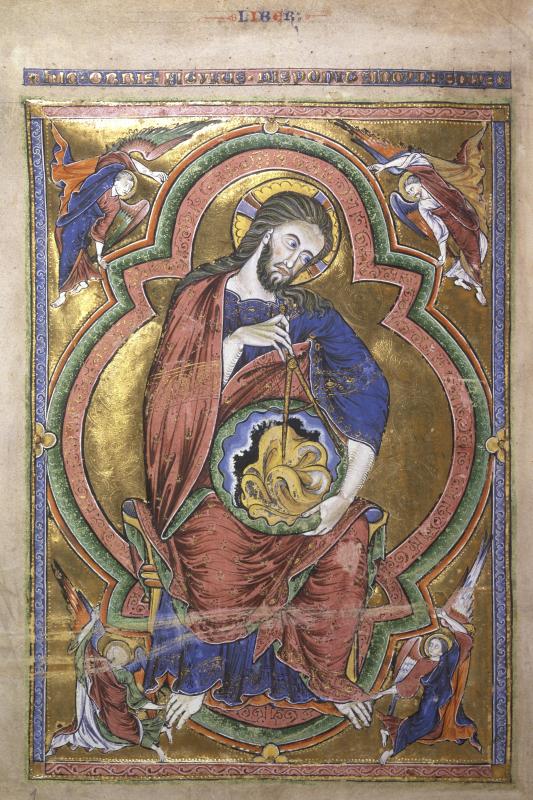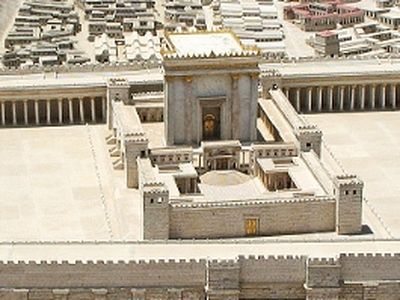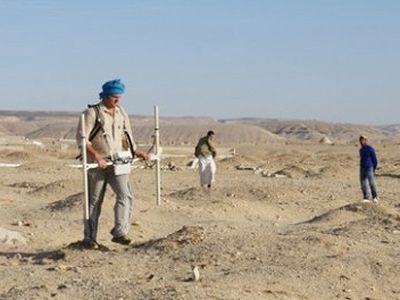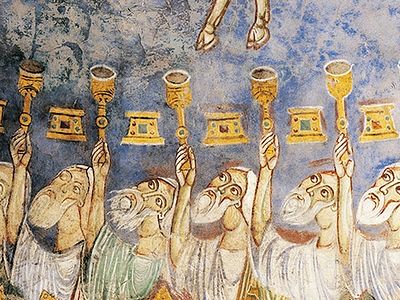Source: Apologia Pro Ortho Doxa
October 31, 2015
We say that God called Israel in order to be a light to the nations and to prepare for the coming of Jesus Christ. However, usually when one gets into the details of how Israel functioned in this fashion, things become murky. Many accounts simply state that Israel, by and large, failed in her vocation so that Israel’s election devolves onto Jesus Christ who finally accomplishes it. There is a sense in which this is true, but it is not the whole truth. Israel’s election was in fact fundamental in preparing the world for the coming of Christ. The only way that one will see this, however, is by taking off the secular glasses given to us by conventional academia and seeing ancient history through new eyes.
The two foundations for seeing history through Christian eyes are the following:
1. Religion. Monotheism, not polytheism, is the earliest religion of humankind, not merely Israel. God made a covenant with Noah in Genesis 9. That covenant is bifurcated into Noahic and Abrahamic forms in Genesis 15. Israel lives under the Abrahamic form of the old covenant, the nations live under the Noahic form of the old covenant. But they are both in covenant with God, and the Noahic covenant is not a covenant of “common grace” but rather a covenant which establishes terms of relationship with God. The nations will establish states with the duty to execute God’s justice. They will be headed by a king entrusted with the mandate of God, the first of which is Father Noah himself. As with Noah, the king simultaneously will function as the head of the cult devoted to the one true God.This is why, throughout the ancient world, virtually all Gentile nations have priest-kings. It is only in the Abrahamic form of the old covenant that priesthood and kingship are divided from one another by divine law.
We are so used to thinking of “Gentile polytheism” and “Hebrew monotheism” that we fail to recognize the one true God in other ancient cultures. According to Daniel and Reveation, the Gentile name for God is the “God of Heaven.” It is no accident, therefore, that the high god in other cultures is very frequently associated with the sky or sun, as the Lord is in Scripture. Moses tells us that the Lord “shines” on us, the Psalmist asks who “in the skies is like the Lord?” The high god of the Roman state is Jupiter, meaning literally “Sky-Father.” We might call this the “Heavenly Father.” The high God of China was Shang-Ti, or “The Emperor of Heaven.” The high god of ancient Egypt is Amun, the “Hidden One.” He is associated with Re, the sun. The high god is a sky-god.
It is undoubtedly the case that these religions very often decayed, in two different ways. Sometimes the high god became more and more distant, so that people would relate to him only through lower gods. This is what happened in ancient China. Shang-Ti became the god of the king, and only the king related directly to him. The rest of the people used magic and prayed to other gods, while recognizing that the Supreme God, the Creator, was Shang-Ti. Another way religion decayed was through making the Creator God more anthropomorphic. This is what happened in the Near East. El is the high God of the Near Eastern world (and this is what the Lord God is called by Gentiles in Scripture), but later in history, he is understood as becoming drunk at feasts, he is depicted, and he fathers children sexually. The same is undoubtedly true with Jupiter (Heavenly Father) and Zeus in Rome and Greece.
We thus understand that all nations had priest-kings, temples, covenants, and sacrifice, because this is part of God’s world, and they all operate under the Noahic covenant, whether in apostasy or in faithfulness.
2. Chronology. The conventional chronology of the ancient world serves to displace God and God’s people from the center of history. The exodus and conquest was a minor event, exaggerated by the biblical authors. Israel was a small, powerless nation with little cultural influence outside of its own borders. Abraham and the patriarchs were wandering nomads. It is no wonder that when we learn biblical history in this fashion, it appears that Israel never really did much as light to the world. I’ve often said that it’s absurd to try to prove biblical history without submitting to the biblical chronology. Given the biblical date for the Flood of 2274 BC, about five-thousand years of history needs to be compressed into two-thousand years. This is a very difficult task, because folding history into its proper place requires a high degree of precision, whereas creating massive historical periods provides much wiggle room to use for fragmentary evidence.
However, it is only within this framework that we will truly understand the Scriptures. The Egyptian Old and Middle Kingdoms are actually concurrent, ad the Egyptian New Kingdom must be moved downwards by about five centuries, so that its birth coincides with the birth of the Israelite monarchy. Consequently:
1. Pre-Dynastic period: From Babel to about the middle of Abraham’s life.
2. Old/Middle Kingdoms: From Abraham to the exodus. App. 430 years.
3. Dark Age: Hyksos/Amalekites conquer Egypt because of its destruction by the plagues. Period of the judges. App. 400 years.
4. New Kingdom: Pharaoh Ahmose enters into a marriage alliance with King Saul (married to the daughter of Ahimaaz), expels the Hyksos/Amalekites from Egypt, and Saul wipes them out, as recorded in 1 Samuel 15. Lasts to about the end of the Israelite monarchy.
What we see here, on a dramatically revised chronology, is that Egypt’s history correlates with changes in Israel’s history. Whenever God remolds the clay of Israel- the center of the human race- He likewise remolds the ancient world.
Let’s take this further.
(Psalm 105:16-22) When he summoned a famine on the land and broke all supply of bread, he had sent a man ahead of them, Joseph, who was sold as a slave. His feet were hurt with fetters; his neck was put in a collar of iron; until what he had said came to pass, the word of the Lord tested him. The king sent and released him; the ruler of the peoples set him free; he made him lord of his house and ruler of all his possessions, to bind his princes at his pleasure and to teach his elders wisdom.
The Psalmist here informs us that Joseph, while in Egypt, taught the Egyptian elders wisdom. According to the book of Genesis, Joseph was a “wise and discerning man.” Within the framework of a dramatically revised chronology, Joseph is the historical person behind the Egyptian figure of “Imhotep” a supremely wise man, a father of medicine and philosophy, an architect, and the man who saved Egypt from a seven-year famine. Conventional historians note in response to this connection that salvation from a seven year famine is a frequent literary motif throughout the ancient world, and is not to be considered historical. But let us ask ourselves: why is it such a frequent motif? I submit that, per Genesis, the famine was across the face of the whole world. After the Flood, the climate still rocked back and forth. For the first few centuries, it was very wet and rainy, with the oceans having been increased in temperature by over twenty degrees celsius, thus generating additional rain. As temperature decreased, we have a short Ice Advance. Then, within ten years (this is based on computer modeling), the climate suddenly rocks essentially its present position. The Sahara Desert is born.This is why famine after famine happens in Genesis, and why there is a massive famine at the end of the book. The tradition of a seven-year famine is a historical memory of the climactic chaos present for the first centuries after the Flood.
Imhotep is the memory of Joseph. David Rohl has pointed out an area within the land of Goshen with a pyramid, a palace, and a colossal statue of a Semite vizier wearing a robe of many colors. In this same location, there are twelve other tombs. This is plainly Joseph and his twelve brothers. This is conventionally dated to the Middle Kingdom, but ancient historians recorded a period of rule by the “Council of Twelve” in the Old Kingdom. Integrating the two kingdoms brings the evidence together. Clearly, Joseph had a great influence on Egyptian civilization.
Joseph was a philosopher. He taught the Egyptians wisdom, medicine, technology, and philosophy. Josephus tells us that when Abraham went into Egypt (it is essential to remember that Abraham is a prince, not a nomad), he taught Pharaoh astronomy. In other words, what God is doing is using Israel to seed the ancient world with philosophy and culture.
Later in history, around the birth of the Egyptian New Kingdom, we discover a flourishing of Egyptian culture and wisdom literature. The cult of Egypt is focused on the person of Amun-Re, whom I have identified above with the one true God. On a revised chronology, this is the early Israelite monarchy, and the flourishing of culture, wisdom, and piety correlates with King Solomon, who taught the world wisdom. Josephus tells us that the queen of Sheba was the “queen of Egypt and Ethiopia”, and the traditional Ethiopian name for the queen is almost identical to the throne name of the famous Hatshepshut. Damien Mackey has argued that Hatshepshut’s chief advisor,Senenmut, ought to be identified with King Solomon, under the spelling of “Shelemoth.”
Solomon is a New Joseph, another great philosopher, and we see that God through Israel again seeds the ancient world with philosophy and culture.
The Greeks said that they received their philosophy from the Egyptians. If this is the case, then the Greeks ultimately received philosophy, as the Fathers declared, from the great Hebrew philosophers- chief among them Joseph and Solomon.
Let me make one final point. The Greeks recall a great lawgiver, Solon, who began as a wise king but gradually came to enslave his people. It is at least plausible, given the similarity of both the name and the narrative, that this is a Hellenized tradition about King Solomon. Furthermore, the Greeks recall that Solon spent a significant amount of time in Egypt. Given the above, this correlates with Solomon/Senenmut’s time in Egypt during the period of peace stretching across the ancient world.
Noah blesses the sons of Japheth and calls them to dwell in the tents of Shem. St. Paul, having grown up in Tarsus, would have studied the great Japhethite philosophers. When God calls him, his goal is not simply to reconcile Jews and Gentiles, but to reconcileJews and Greeks. Paul’s vocation, both literally and symbolically, is that of the tent-builder. He builds up Shem’s tents so that Japheth may come and glorify it with his philosophy and culture.
Through this survey of history, we have seen, however, that this culture did not develop in a vacuum. God repeatedly seeded the ancient world with Hebrew philosophy and culture, so that while He was growing Israel up to maturity, He was likewise preparing the nations for the coming of Christ. This trajectory climaxed in the coming of Jesus Christ, the marriage of Noahic and Abrahamic covenants, producing what Fr. Georges Florovsky called Christian Hellenism.
It is time that we see the world through new eyes. Neither God nor His people have sat on the sidelines of history. They both are at the center of history, the goal of which is the birth of Jesus Christ and the divinization of all mankind.




